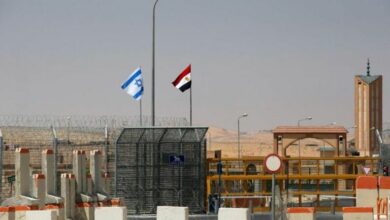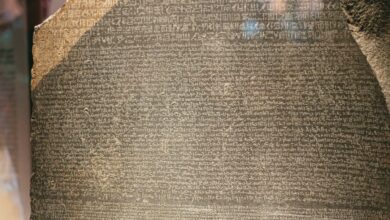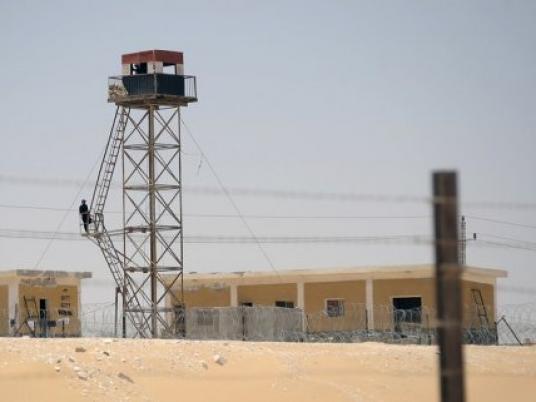
There are streets that we walk through every day, and it’s quite likely we feel that we know them. We have encountered the folks that inhabit them: the newspaper vendors, tissue peddlers, the creeps, the showmen. We are familiar with their conspicuous physical attributes: nooks, crannies, passageways, mosques, posters, graffiti, oddly spelled advertisements. Then there are the sounds of a particular area. The bekya man, the cotton candy horn, and chants of “Yaskut yaskut hukm al-askar” (Down, down with military rule) skirting through downtown streets, determinedly thundered, then dispersing.
But these notions about space, ownership and territory are intensely personal, political and specific, argues the engaging Elizabeth Metzger Sampson, who launched the “Radical Mapping” workshop at the Nabta Art Center last month. Coincidently, just down the street from Nabta, there was an exhibition at Mashrabiya Gallery called “Maps Miracle,” dealing with similar media and themes.
Space is no more than the way we choose to perceive it, and, in effect, own it. To create our environments, we continuously sift through endless stimuli, constructing meaning. That is the purpose of radical mapmaking, re-conceptualizing the way we perceive allocated space and whatever else humanity considers worthy of registering within a particular locale at a particular moment.
As Sampson says: “Historically, maps have been a colonial practice — one to divide national boundaries, designate private property, and later to depict the fixed form of street grids. But a map can be many things: a map of the smells one experiences on a daily walk from home to work, a map of the signs one sees, of blockades navigated, of the politics that affect a life. A map can be one minute of audio from one’s daily experiences.”
So we broke off into groups at the workshop and documented the streets that we thought we knew in a way that could be of consequence for us. It felt very brave. We knew the streets that we were documenting, and had walked them more times than we could count, but just because you know where you’re going doesn’t mean that you think you belong there. The confrontation that my partner and I created in attempting to mark “gaze” was probably an experiment that will not be repeated.
We marked it in the two ways that we could think of: faceless mannequins and staring passersby. We gazed, they gazed; we recorded. Man: notebook in hand, squiggles drawings of circles and lines while walking intently. The map appears inconsequential and childlike. Woman: ogling men on street. Ogling. Asking to be ogled. Ogled. What we hadn’t accounted for was that taking pictures and chasing people that looked at you makes a scene that naturally causes a lot more people to look at you, an important lesson in the subjectivity of the record. Many photographs were taken that day.
This dialectic between the subjective and the “official” place was also the subject of “Maps Miracle” at Mashrabiya Gallery. The two exhibiting artists, Salah El Mur and Souad Abdelrasoul, together repurposed maps and diagrams that form our conceptions of body and country for something distinctly personal.
Crucial to the science of modern mapmaking (your average textbook map with lines and borders that you assume to be accurate), which emerged in the 14th and 15th centuries, is the semblance of objectivity. Land was documented for the purposes of colonialism, yet even the colonizer needed pretext. An argument that the scientific world demands the rational and logical classifying of its constituent parts was presented to defend this documentation. Jagged masses of land were stamped, parceled, labeled and given to those who were most likely doing the mapmaking to begin with.
Abdelrasoul and Mur took the documents that are evidence of these power structures and claimed them, using fragments of maps and scientific illustrations of the human body; they wrote over the dominated, colonized and resettled with the natural, the feminine and the verdant.
Using pen and ink, they drew faces over the maps, fish out of esophagi, African masks with long legs. A map of the Canary Isles became a woman: heavily pregnant, reclining in the petals of a leafy flower, an earth mother. The map’s label became the fetus in utero. The land comes before its name, and will exist after it. One map was of South Africa, but you wouldn’t really notice unless you wanted to. It was turned on its side and embedded in a black, inky face looking out into a dusty gouache blankness.
Without erasing the central idea in mapmaking (depicting location/place), Abdelrasoul and Mur enriched it in terms of the personal and the human. Borders were filled in with signs of life. These islands were occupied, no longer labeled for the purposes of occupation, but for the purposes of displaying the organic. This is exactly what Sampson was getting at too.
What both “Radical Mapping” and “Maps Miracle” had in common was the vindication of the lived experience, and our interpretations of life — as chaotic and flawed and dimwitted as we are. For humanity and the map it is a persistent proposition: we are here, but where is that?





